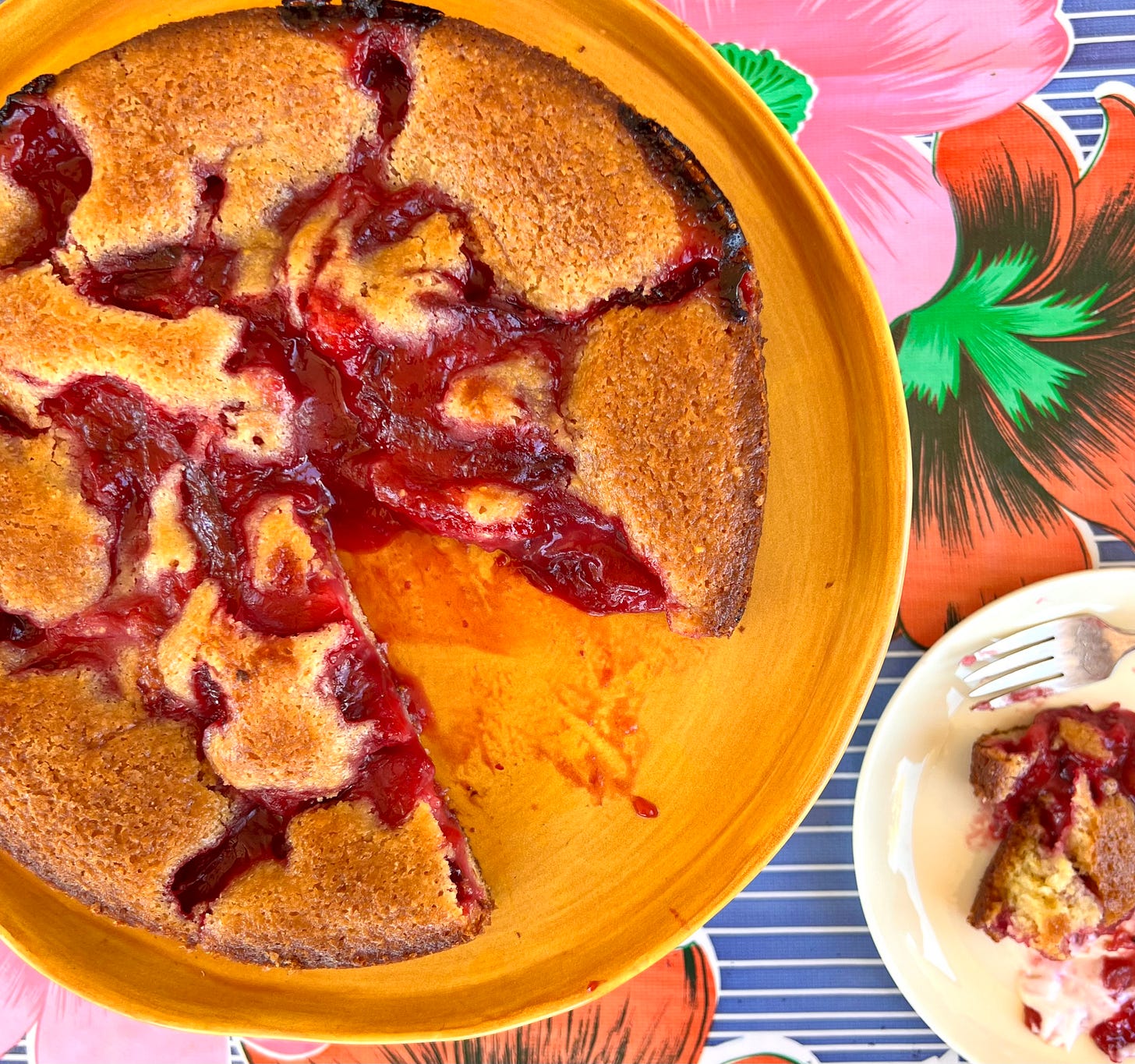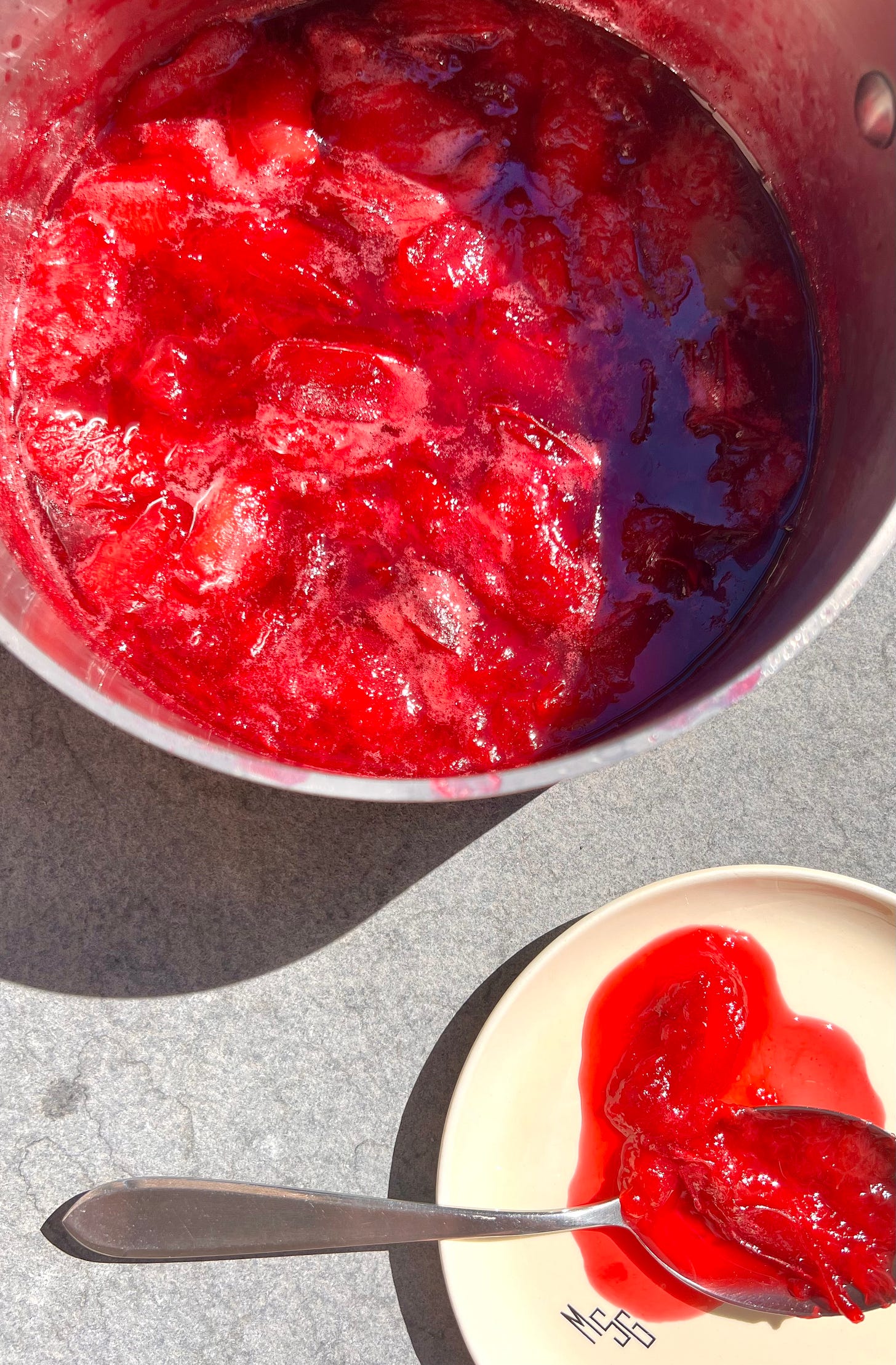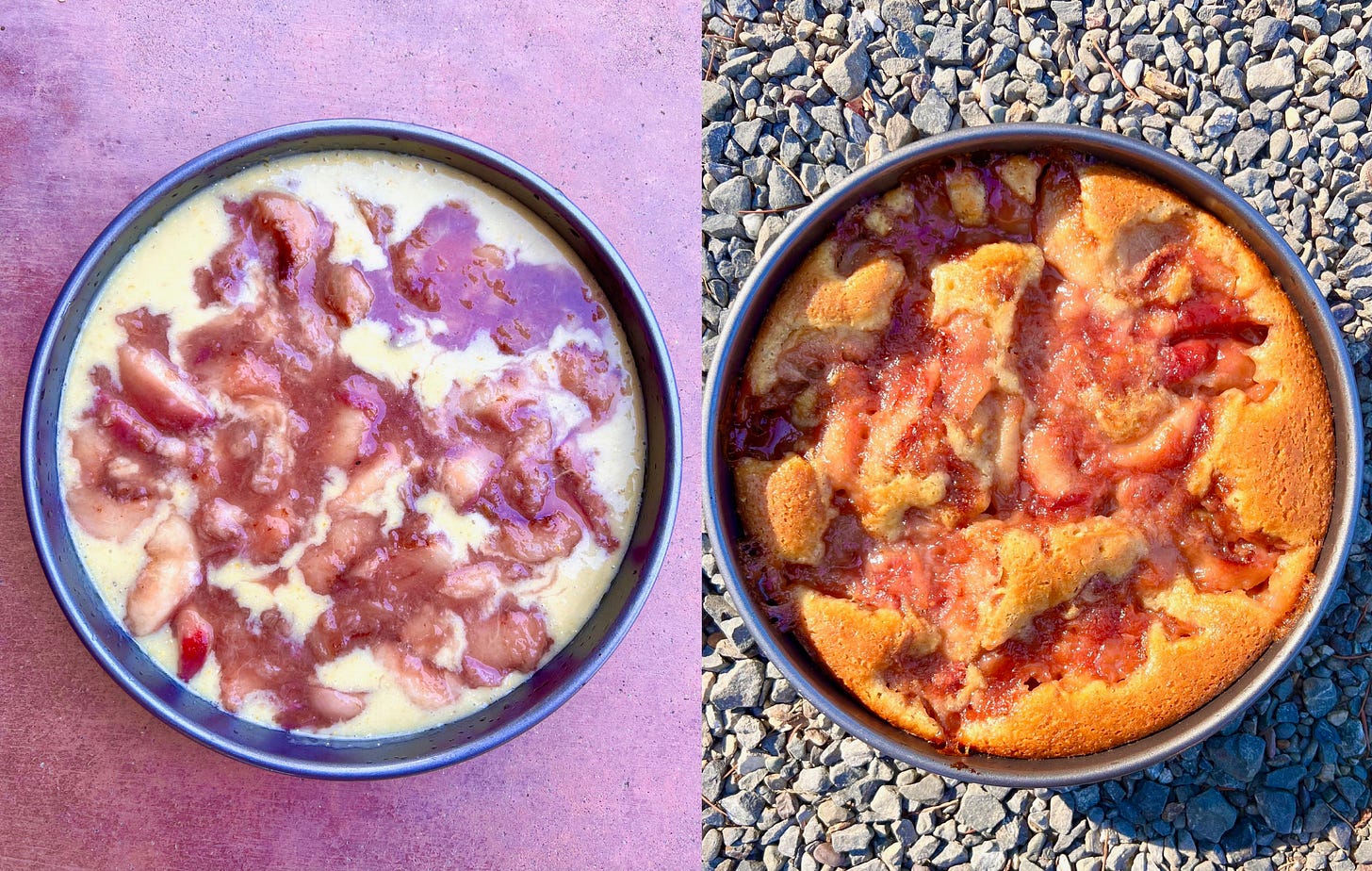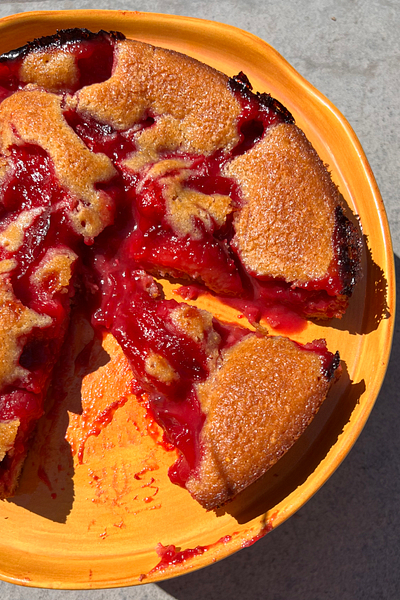When Worlds/Dreams Collide
And a Recipe for Polenta-Plum Olive Oil Cake/Pie
I’m sitting in my little kitchen nook, plotting (fine, struggling with) the intro for this week’s recipe. At a loss, I text the phrase, “WRITER’S BLOCK” to my writer friend. Within a millisecond I hear back, “Hi.”
I exhale. A pulse at the other end of my plea. “Tips, tricks, wisdom. Please,” I request. Silence. She responds with nothing. Sometimes sitting with the blank page is all there is to do. We both know it.
I gaze down at the bowl next to my laptop, containing my seventh attempt to snack myself into inspiration. And then it all becomes stupidly obvious (and serendipitous): staring back at me was the heart and soul of this week’s recipe, in strawberry and apricot form.
JAM! IT MAKES THIS CAKE A PIE.
Allow me to anatomize the interior of a fruit pie: Fruit, cornstarch or flour, sugar, cubes of butter, sometimes lemon juice. (And never forget the generous pinch of salt.)
Inside an oven, enclosed within a top and bottom pie crust, this mixture heats slowly, eventually gurgling and reducing, effectively transforming into a starch-thickened jam, made richer by the fat of the butter.
Cut to this week’s cake/pie recipe: throw plums and sugar in a pot and simmer vigorously for 15 minutes, until thickened. Add some additional plum wedges at the end for freshness and simmer for a minute more. Voilà: JAM. Dollop spoonfuls of this jam atop a straightforward (but souped-up) cake batter and bake. What occurs in the oven when this homemade jam melds into the flour and fat of the cake batter is not unlike what happens during the magical moment of fruit, flour, and fat transforming into a pie’s schmooey-gooey filling.
And so, your honor, please refer to the evidence presented that substantiates the presence of pie in the confines of this dessert’s cake-like circumference: it comes in the form of… jam.
THE COMBO PLATTER
I recognize the brazen declaration I’m making: this Polenta-Plum Olive Oil Cake/Pie is a Cake/Pie. That is to say, it is both a cake and a pie. I will also acknowledge that the photos and written recipe don’t evoke anything beyond a cake. Or depending on how much you’re squinting, maybe an upside-down cake. But NOODLERS, there’s truth to the pie angle!
What I’m presenting is a recipe that balances cake and a pie by isolating the beauty of a pie’s interior and then surrounding it with cake. Plus! There’s another BOBW* thing happening here (and also the use of an acronym that has yet to be super colloquial): the ease of a cake (with a one-bowl, no mixer- required batter) and the goosebumpery that only a pie can deliver.
If only there were a more clever portmanteau than “Cie” or “Pake” to really take my argument over the finish line. Sigh.
THE POWER OF THE PLUM
Growing up in the middle of a metropolis, the summer jamming season– using Santa Rosa plums picked right from our city-center backyard– was my brief moment of country living each year. I continue to crave that. (The jam and the gingham.)
When cooked down, plums become richer and deeper and darker expressions of themselves, redolent of adjectives best suited for describing fine and rare wines or moody silent films from the ‘20s. And yet, perhaps because of the coalescence of sour skin and sweet flesh, what presents alongside a plum jam’s dramatic depth of flavor is also something delightfully… bright. Furthermore, and controversially (within the stone fruit scene, that is), I believe that truly mind-blowing plums are really hard to find and so in general, plums are the best versions of themselves when baked into jam! I said it!
THE INSPO
The batter for this cake/pie was inspired by Southern chef Virginia Willis and her grandmother’s recipe for blackberry cobbler. During my years as a cook on the Martha Stewart Show, I crossed paths with Chef Willis when she appeared as a guest. She made the recipe on camera and bounced, leaving behind a warm cobbler that I likely crushed single-handedly. Since then, I’ve been making variations on her grandmother’s recipe for over a dozen years, which is totally crazy to think about, as is the fact that I’ve never reached out to express my appreciation. Now that I’ve transformed her grandmother’s epic cobbler recipe into a cake/pie, maybe I’ll send her this newsletter.
POLENTA + OLIVE OIL… WAY TO BRING IT HOME
Olive oil in a cake? Of course. But ever had olive oil in a pie? Me neither. Until now. It’s a bit of a no-brainer, marrying the deep, savory quality of olive oil with those moody-broody plums. Adding polenta for crunch and texture feels like the fitting, final touch, and ultimately makes me feel that my Italian degree in college is coming in handy. Un po’ di polenta, un po’ d’olio d’oliva. Fanno buona, la torta.
*BEST OF BOTH WORLDS
POLENTA-PLUM OLIVE OIL CAKE/PIE
Serves 8-10
REMEMBER, BEST PRACTICE: READ THE RECIPE ALL THE WAY THROUGH BEFORE YOU START COOKING!
That’s right, a cake/pie. Best of both worlds: the texture (and ease) of a cake with the interior (and goosebumpery) of a pie. Start by making a simple stovetop jam, which simulates a pie filling when baked into a cornmeal-flecked, olive oil-based batter.
I love using red-fleshed plums or pluots. If you can find them, Santa Rosa plums are my favorite. Other stone fruit can be subbed in, sure, but there’s a magical thing that happens when you turn fresh plums to jam…
This cake/pie is best eaten the same day it is made.
2 pounds firm but ripe plums (pluots are also great here)
1 cup granulated sugar, divided
Kosher salt
½ cup extra-virgin olive oil, plus additional for greasing pan
¾ cup all-purpose flour
⅓ cup medium grind polenta or cornmeal
1 ½ teaspoons baking powder
¾ cup whole milk
Ice cream, crème fraîche, or unsweetened whipped cream, for serving
1. Cut 2 pounds of plums in half and twist to open. If fruit is super ripe, work over a bowl to catch any juices. Using your fingers or a small spoon, remove the pits and discard. Cut each half into fourths.
2. Add half of the sliced plums to a medium pot, along with any accumulated juices. (The remaining plums you’ll add at the very end of cooking.) Add ¼ cup sugar, a generous pinch of salt, and stir to combine. Place over high heat. After about 1 minute, when the mixture begins to sizzle, give the plums a stir and cover with a lid. Reduce heat to medium and let cook, 5 minutes.
3. Uncover the pot. Adjust heat to maintain a brisk simmer. Cook, gently stirring occasionally, until plums are broken down, the mixture has reduced, and the juices have become more concentrated, about 8 to 10 minutes. (You can tell that the jam has turned more viscous if the bubbles in the pot appear slightly larger and more syrupy than when you first uncovered the pan.)
4. Add the reserved sliced plums, gently fold to combine, and cook 1 minute. They will soften as they sit but you want this batch to retain their shape, so don’t overcook. Remove from the heat and let sit until the jam has cooled a bit. (You should have between 2 ½ and 2¾ cups of jam.) If desired, hasten the cooling by scraping the mixture into a heatproof container and transferring to the refrigerator. This step can be done up to 2 days in advance. Keep mixture chilled, covered, until ready to bake.
5. Preheat the oven to 350 degrees with a rack in the center. Lightly grease a 9-inch x 2-inch cake pan with olive oil. Cut a round of parchment to fit into the bottom of the pan and lightly grease.
6. In a medium bowl, whisk to combine ¾ cup flour, ⅓ cup cornmeal, 1 ½ teaspoons baking powder, and ¾ teaspoon salt. To a large bowl, add ½ cup olive oil, the remaining ¾ cup sugar, and ¾ cup milk. Whisk to combine. Add the dry ingredients to the wet ingredients and whisk until smooth.
7. Scrape the batter into the prepared cake pan. With a spoon, dollop mounds of the jam mixture all over the top, creating pockets of plum and letting pockets of batter shine through. It will seem like a lot of plums– don’t worry, you’re doing this correctly! Using a toothpick or skewer, gently swirl the pockets of jam into the batter, just ever so slightly. Don’t over-swirl: your aim is to disperse the jam just a bit into the batter, not mix the jam and batter together.
8. Transfer pan to the oven and bake, rotating halfway through, until the cake parts of the pan are golden brown on the edges and beginning to turn golden in the center, about 50-60 minutes. Remove from the oven and let cool until the bottom of the pan is warm to the touch, about 1 hour. If cut when too hot, the cake/pie may not hold its shape. Cut into wedges and serve, with ice cream, crème frâiche, or unsweetened whipped cream. Cake/Pie is best consumed the same day it is made.
If you want to invert onto a cake plate for serving, let the cake/pie cool until the bottom of the pan is only slightly warm to the touch. Run a knife around the edge to loosen. Place a large, flat plate over the top of the pan and flip to invert, so that the top of the cake/pie is now face-down. Remove the parchment round. Working swiftly, place your serving plate or cake stand on top of the cake/pie and, gently holding the two plates with the cake/pie now sandwiched between, flip to re-invert, so that the top is facing up again.













Yum, this looks beautiful!!
Nora! I love that you are here, in your true, vibrant, beautiful, colorful voice as always. And this cake, heavenly!!